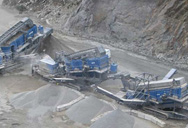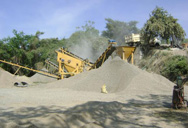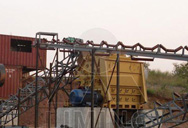milling heap leach

SPECIAL REVIEW ARTICLE Heap leach modeling - Springer
2018.12.17 application of run-of-mine and crushed ore heap leaching for illustrative purposes. Of course, in practice either run-of-mine or crushed ore heap leaching may be
More
Heap Leach Production Modeling: a Spreadsheet-Based Technique
2019.9.3 A range of delay times (t d) of about 7 to 20 days is anticipated by the authors for most heap leach situations. This comparative analysis illustrates that effective
More
Heap Leaching - an overview ScienceDirect Topics
Heap Leaching In HL mined ore is crushed into small chunks, or ground and agglomerated into quasi-uniform particles, and heaped on an impermeable plastic and/or clay lined
More
A Methodology For Design And Operation Of Heap Leaching
2017.3.7 Heap leaching is a hydrometallurgical process that, due to its economic and environmental advantages, is considered as a standard treatment for the extraction of
More
Heap Leaching of Gold and Silver Ores - ScienceDirect
2016.1.1 Georgius Agricola, in his book De Re Metallica (published in 1557), illustrates a heap leach with a 40-day leach cycle (Figure 25.1), which could pass in
More
Heap leaching as a key technology for recovery of
2015.9.10 Optimally, heap leaching should be a low-cost technology for the recovery of values from low-grade ores, suitable especially for remote mine sites. However, the
More
A Brief Note on the Heap Leaching Technologies
2019.6.17 Heap leaching is a low-cost technology used in industrial mining to recover precious metals such as gold and uranium, along with several other highly sought after metals like copper, from their...
More
Heap Leaching Process Mining Techniques - DRTS
2019.1.10 Heap leach mining is an industrial hydrometallurgical process, where the metal contained in an ore body is extracted by dissolution. The target mineral is leached
More
Sustainability Free Full-Text A Brief Note on the
2019.6.17 In the 1950s and 1960s, ores containing less than 0.05% uranium were periodically refined in small heaps. There are three methods used for uranium recovery, namely: traditional milling, in situ recovery
More
Sorting through the heap - Canadian Mining Journal
2020.9.1 A recent study by CostMine focused on the costs and challenges when developing gold heap leach projects. This study looked at 375 projects worldwide that currently recover gold from heap leach
More
Equinox Gold Announces Positive Feasibility Study
2021.3.22 The 2021 Feasibility outlines an expansion of the mine that will include a 45,350 t/d ROM heap leach facility and a new 3,200 t/d milling and leach/carbon-in-leach ("CIL") plant for higher grade ore. The existing
More
Heap Leaching Process Mining Techniques - DRTS
2019.1.10 Heap leach mining is an industrial hydrometallurgical process, where the metal contained in an ore body is extracted by dissolution. The target mineral is leached with an aqueous solution whereby the mineral is dissolved into what is called a “pregnant” solution which, is then captured and later recovered downstream in the processing line.
More
Fort Knox Gilmore Expansion Project, Alaska, USA - Mining
2020.3.30 The CIL mill operates throughout the year at a nominal capacity of 36,287 tonnes a day of fresh feed. Run-of-mine (ROM) ore is hauled uphill from the pit and existing stockpiles and is dumped onto leach cells. The Gilmore ore will be stacked at the new Barnes Creek Heap Leach (BCHL) pad which will operate in line with the WCHL leach pad.
More
A Brief Note on the Heap Leaching Technologies for the Recovery
2019.6.17 Chart of a gold heap-leach operation (adopted and modified from the reference 43). Sustainability 2019, 11, 3347 6 of 10. 2.3. ... uranium recovery, namely: traditional milling, in situ recovery ...
More
Heap Leaching of Gold and Silver Ores - ScienceDirect
2016.1.1 A heap leach typically achieves ∼25% less gold recovery than a mill. The operating cost plus debt service for a medium-sized mill (3000 t/d) is typically $39/t of ore treated, whereas the comparable cost for the heap is $19/t, equating to a differential operating cost plus debt service of $20/t for milling compared with heap leaching.
More
Effect of the particle size and microstructure ... - ScienceDirect
2021.3.1 High-pressure grinding rolls (HPGR) technology is a valuable way to improve the extraction efficiency of valuable minerals; however, the excessively fine particles of the HPGR products affect the heap permeability and limit its application in heap leaching.This study aims at investigating whether the HPGR products can still be leached
More
DeLamar Gold-Silver Project, Idaho, USA - Mining Technology
2022.3.23 The heap leach and milling operations will be supported by an on-site laboratory. Infrastructure of the gold-silver project. An on-site hybrid microgrid comprising different energy sources, including solar, battery, and liquefied natural gas (LNG) generators is proposed to meet the power requirements of the project.
More
HEAP LEACHING TECHNIQUE in MINING - Euromines
2023.11.10 Also, slope stability evaluations of stacked heap leach pads are performed using standard geotechnical engineering principles and practice. Therefore, in accordance with ... All of these processes require crushing and/or, grinding/milling of run-of-mine ores for liberation
More
Integra Completes Pre-Feasibility Study for Delamar Project
2022.2.10 The process flowsheets for both the Heap Leach and Milling circuits have been designed around historical test work from the 2019 PEA and metallurgical studies completed in 2020 and 2021.
More
KEYNOTE: HPGR in Gold Leach Applications – an Overview
5 天之前 • Indications that HPGR use will result in both lower retained and saturated moisture in the heap (depending on the ore/rock type). • Even with variable rock types and alteration, HPGRs can generate discharge products which (a) exhibit good agglomeration and (b) show favorable PSDs for geo-technical heap stability. • Faster leach kinetics.
More
Heap leaching as a key technology for recovery of
2015.9.10 1. Introduction. Heap leaching forms part of the group of technologies known as percolation leaching, which includes in situ leaching, dump leaching, heap leaching and vat leaching (Bartlett, 1998, John, 2011).Common to all these technologies is migration of leach solution through a fixed bed of ore particles, on its path interacting with
More
(PDF) Energy Efficiency Copper
2007.12.31 Crush, heap leach, SX, EW (Base case)-with alternative anodes-with ferrous/ferric reaction . 28,51 1. ... Three different mill rotational velocities are evaluated in the simulation, according to ...
More
Real and Potential Metallurgical Benefits of HPGR in
2018.2.20 demonstrate the improved heap leach rates and leach recoveries pos-sible from this ore type as a result of HPGR. Baum (1997) used dye-impregnation to demonstrate micro-fractures in HPGR product particles. (Fig.4). Patzelt et al (1996) showed column leach test results indicating that the heap leach improvement benefits of HPGR over
More
Commercial heap biooxidation of refractory gold ores –
2017.5.15 Section snippets Small pilot heap test summary. A Refractory Leach Test Facility to construct the first small pilot heap (476 t) was authorized by Newmont management in 1990, and constructed adjacent to the Gold Quarry pit at Newmont’s Carlin Mine.By 1994, a series of successively large heaps were operated in different areas of
More
Low Cost, High Returns: How Gold-mining Operations Benefit from Heap ...
2021.6.15 Building and permitting a mill to process mined resources can take at least a decade, not to mention a large outlay of capital. ... heap leach, low-cost mining targets,” said CANEX Metal CEO Dr ...
More
Integra Completes Pre-Feasibility Study for Delamar Project
2022.2.10 The process flowsheets for both the Heap Leach and Milling circuits have been designed around historical test work from the 2019 PEA and metallurgical studies completed in 2020 and 2021.
More
Fact Sheet on Uranium Recovery NRC.gov
2015.6.29 In heap leach operations, small pieces of uncrushed ore are placed in a "heap" on an impervious pad of plastic or clay with perforated pipes under the heap. An acidic solution is then sprayed over the ore to dissolve the uranium it contains. ... After license termination, conventional mill or heap leach facilities are transferred to the
More
Conventional Uranium Mills NRC.gov
A conventional uranium mill is a chemical plant that extracts uranium using the following process: Trucks deliver uranium ore to the mill, where it is crushed into smaller particles before being extracted (or leached). In most cases, sulfuric acid is the leaching agent, but alkaline solutions can also be used to leach the uranium from the ore.
More
Integra Announces Simplified Strategy to Advance
2022.4.21 The heap leach stand-alone mine will no longer require the permitting and construction of a mill or a 97-hectare tailings storage facility, significantly reducing land disturbance and permitting risk
More
SHEEP MOUNTAIN URANIUM PROJECT CROOKS GAP,
2010.9.8 – Active heap is active “milling” • Ati H t ili t11 (2)b d tActive Heap material is not 11e.(2) byproduct – “Resting” a heap is part of active milling – Have rad. monitoring and rad. protection programs to ensure public and occupational exposures remain ALARAexposures remain ALARA – Heap becomes 11e.(2) when drain down and
More
2022 Domestic Uranium Production Report - U.S. Energy
2023.5.31 At the end of 2022, the White Mesa Mill in Utah was operating with an ability to process 2,000 short tons of ore per day. Shootaring Canyon Uranium Mill in Utah and Sweetwater Uranium Project in Wyoming wer e on standby with a total capacity of 3,750 short tons of material per day. In Wyoming, the Sheep Mountain heap leach facility remains
More
A conceptual flowsheet for heap leaching of platinum
2012.1.1 During the milling and flotation of platinum group metal (PGM) concentrates, particularly of Upper Group 2 (UG2) ores, cleaning flotation can often deliver both a high-grade and a low-grade concentrate which may be dispatched as a blend to the smelter. ... The concentrate can then be washed off the heap leach support material and washed
More
Nevada Gold Mines, US - Mining Technology
The Phoenix gold mine in Nevada produced 15 million pounds of copper in 2019. The gold production dropped by 60% owing to just six months of operations in 2019 as compared to a full year in 2018. Established in
More
Precious Metal Heap Leach Design and Practice - Ore-Max
2023.1.20 Comsur's Comco silver heap leach at Potosi, Bolivia, showed the same recovery in both a heap and an agitated leach plant. However, the silver ore leached very slowly and residence time of up to 4 days was needed in an agitated leach plant. Although the heap leach took several months to achieve the same recovery, the economics
More
(PDF) Heap leaching as a key technology for recovery of
2015.9.1 Precious metal heap leach design and practice, in Proceedings - Mineral Processing Plant Design, Practice and Control, SME, Colorado, USA, ISBN 0-87335-223-8, Vol.2, 1606-1630.
More
TENORM: Copper Mining and Production Wastes - US EPA
2016.9.14 Heap Leaching. In contrast to dump leaching, heap leaching refers to the application of chemicals to low-grade ore that has been crushed and deposited on a specially designed pad. The pad is lined with synthetic or natural materials such as polyethylene or compacted clay. Copper heap leach operations are much smaller than
More
Cyanide Use in Gold Mining - Earthworks
A sodium cyanide solution is commonly used to leach gold from ore. There are two types of leaching: Heap leaching: In the open, cyanide solution is sprayed over huge heaps of crushed ore spread atop giant collection pads. The cyanide dissolves the gold from the ore into the solution as it trickles through the heap.
More
Heap Leaching - 911 Metallurgist
2016.6.13 Copper heap and dump leaches in southern Spain were common by about 1700. Gold and silver heap leaching began with the first Cortez heap leach in 1969. While many projects have come and gone, Cortez is still going – their new 63,000 tonne/day South Area leach is scheduled to start up in 2002. The largest U.S. precious metal heap leach
More
SPECIAL REVIEW ARTICLE Heap leach modeling - Springer
2018.12.17 the options available for heap leach modeling, discusses the advantages and disadvantages of each approach, and provides guidelines/recommendations for an effective approach to modeling metal production at existing or planned heap leach operations. The paper also provides expected ranges of variation between actual and
More
Nifty Copper Mine, Pilbara, Western Australia - Mining
2020.7.15 The current heap leach and solvent extraction/electrowinning (SX/EW) will be recommissioned to process the ore from the open-pit operation. ... (SAG) mill, ball mill, filter plant, flotation cells, concentrator thicker, tails thickener, and paste fill plant. It is expected to have a long-term annual processing capacity of 2.8Mt. ...
More- تجزیه و تحلیل مالی برای سنگ شکن
- الجرانيت معدات طحن الكلنكر
- محطم مخروط كيف الاشياء يعمل محطم
- سنگ زنی untuk mesin kaptan
- پیوستن ابزار نوار نقاله
- كسارات مخروط الذهب تتعامل على نطاق واسع في آلات التعدين
- كسارة vsi المحمول وبيع
- معالجة الدولوميت مصنع باتو بيع
- آلات معالجة خام النحاس السوداني في الولايات المتحدة الأمريكية
- استكشاف أخطاء محطم كسارة
- سنگ شکن فکی بزرگ 1000 تن در ساعت
- machinerycrusher گیاه در اروپا
- منتجات الحجر الجيري في تنزانيا
- التلقائي بالكامل غسالة كجم
- أنواع الصخور والمعادن في الفلبين